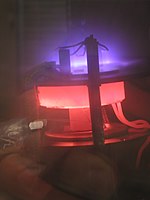
Photo from wikipedia
Plasma-assisted combustion is a promising approach to achieve fast ignition and highly efficient combustion. In this work, methane–air nanosecond pulsed dielectric barrier discharge plasma-assisted combustion is numerically investigated by combining… Click to show full abstract
Plasma-assisted combustion is a promising approach to achieve fast ignition and highly efficient combustion. In this work, methane–air nanosecond pulsed dielectric barrier discharge plasma-assisted combustion is numerically investigated by combining a homemade plasma model with the combustion model of software CHEMKIN-PRO. Effects of varying applied voltage amplitudes on the characteristic parameters of the plasma-assisted planar shear flow combustion as well as the reaction pathway maps of not only the nanosecond pulsed dielectric barrier discharge plasma but also the combustions without and with plasma assistance are systematically illustrated and analyzed. The simulation results indicate that under the combined action of increasing electric field intensity and increasing charged particle densities, the peak value of the discharge current density increases, and the peak time of the discharge current density is brought forward with the increase of the applied voltage amplitude. The temperature reaches its peak value earlier in the methane–air combustion with plasma assistance than without plasma assistance. The maximum temperature reduces to around 1900 K when the applied voltage amplitude is higher than 11 kV. There are emerging pathways to generate hydrocarbons C2H4 and C2H2 in the plasma-assisted combustion, the reactions of CH4 on CH and C2H on H2, respectively. The reactions involving active species such as H play a significant role in the plasma-assisted combustion, which causes an obvious decrease in the densities of these active species with plasma assistance.
Journal Title: ACS Omega
Year Published: 2020
Link to full text (if available)
Share on Social Media: Sign Up to like & get
recommendations!